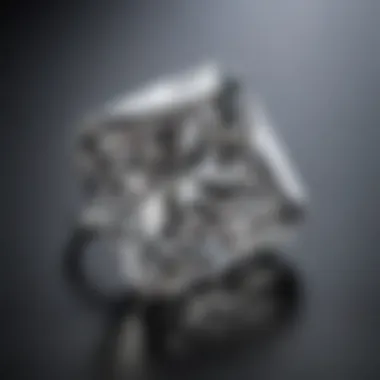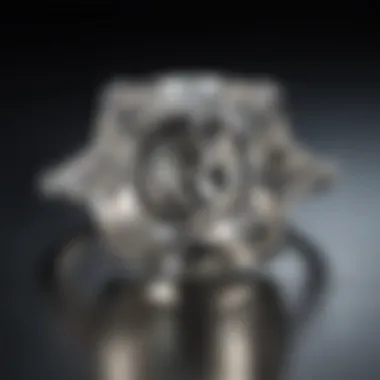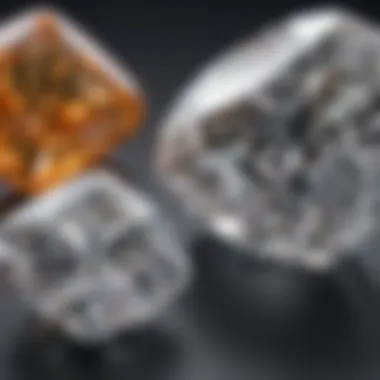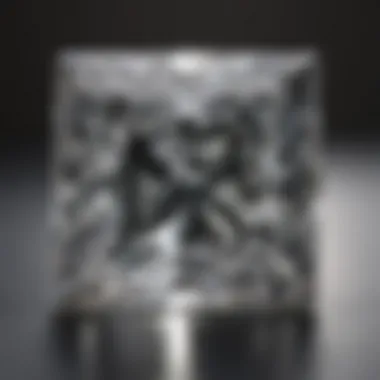Princess Cut vs. Cushion Cut: Key Differences Explained


Intro
When stepping into the world of diamonds, consumers often find themselves navigating a complex sea of options. Two cuts that shine with particular brilliance are the princess cut and cushion cut. Both of these shapes offer unique attributes, distinct aesthetics, and their own place in the history of jewelry design. Understanding the nuances between them can be a game-changer for those looking to invest, propose, or simply appreciate the beauty of these gemstones.
In this article, we aim to dissect the various aspects of these cuts, exploring their origins, distinctive features, and how they coexist in contemporary diamond jewelry. Whether you are a gemstone enthusiast, a collector, or a designer, this detailed analysis serves as a guide for making informed choices that resonate with individual tastes and preferences.
Gemstone Overview
Description of the gemstone
Diamonds are not only revered for their unparalleled sparkle but also for their diverse forms. The princess cut is characterized by its square shape and sharp corners. It is designed to maximize light reflection, resulting in a dazzling display of brilliance. On the other hand, the cushion cut, often called a pillow cut, boasts a softer, rounded square appearance with visible facets. This shape is more traditional and offers a vintage vibe that many cherish.
Physical properties
Diamonds primarily consist of carbon atoms arranged in a crystal structure. Their hardness rates a staggering 10 on the Mohs scale. However, when we delve into the specifics of the princess and cushion cuts, we notice some differences in their physical properties:
- Princess Cut:
- Cushion Cut:
- Corners: Sharp, yielding a modern elegance.
- Total Depth Percentage: Generally ranges between 60% to 75%, impacting how light interacts with the stone.
- Faceting Pattern: Typically features a grid-like pattern that enhances sparkle.
- Corners: Rounded, promoting a softer appearance.
- Total Depth Percentage: Usually around 58% to 68%, giving it a more antique feel.
- Faceting Pattern: Displays larger facets that provide a more romantic, glow-like appearance.
Key Differences
Understanding the key differences can help consumers make educated decisions when purchasing diamonds.
- The princess cut is more modern, while the cushion cut harks back to a bygone era.
- Light performance varies; the princess cut tends to create a more dazzling brightness, while the cushion cut offers a subdued yet warm glow.
- The choice between the two also affects the overall style of jewelry; for instance, princess cuts are often used in contemporary rings, whereas cushion cuts lend themselves well to vintage-inspired settings.
Culmination
In summary, the choice between a princess cut and a cushion cut diamond extends beyond mere aesthetics. It encapsulates personal taste, the significance of the occasion, and the style of jewelry being sought after. As we delve deeper into historical contexts, cutting techniques, and emotional values tied to these cuts, we will illuminate what makes each of these gemstone options a worthy consideration for any discerning shopper.
Prelims to Diamond Cuts
Choosing the right diamond cut is more than just a personal preference; it's a critical decision that affects the overall beauty and brilliance of a diamond. The cut determines how light interacts with the stone, influencing how it sparkles and reflects light. In this article, we will journey into the fascinating world of diamond cuts, with a special focus on the princess cut and cushion cut. Both of these styles have unique histories and characteristics that make them popular among gemstone enthusiasts and collectors alike.
When discussing diamond cuts, it is vital to recognize their importance in symbolism and personal taste. A diamond is often considered the ultimate expression of love and commitment, making the choice of cut even more significant. Selecting a diamond involves understanding not just the design but also its implications— whether it be in terms of personal aesthetics or cultural significance.
The purpose of this section is to offer a foundational understanding of diamond cuts. It will set the stage for deeper exploration into the distinctions between princess and cushion cuts. By grasping the nuances of these cuts, consumers can make more informed decisions when purchasing or designing jewelry. From historical relevance to technical aspects, this introduction aims to equip readers with essential insights that will enhance their appreciation of this timeless gemstone.
Understanding Diamond Cuts
Diamonds come in various cuts, each with its techniques and distinct aesthetic. The term "cut" not only refers to the shape of the diamond but also encompasses how well the diamond has been crafted. The cut can significantly impact the stone's brilliance and fire—the qualities that make diamonds so captivating. For example, a well-cut diamond will reflect and refract light more effectively, resulting in greater sparkle.
A diamond's cut is one of the most important factors in determining its value, second only to the carat weight. Let’s unpack some of the common terms associated with diamond cuts:
- Brilliant Cut: This cut maximizes light reflection, often characterized by a round shape, which is highly favored for its sparkling effect.
- Step Cut: Shaped like stairs, typically found in emerald and Asscher cuts, it provides a more subdued brilliance, emphasizing clarity over sparkle.
- Modified Cuts: These include variations that blend traits from different cuts, adding unique touches to traditional forms.
Understanding the different cuts also involves knowing how they were developed over time. The evolution of diamond cutting techniques has drastically changed how diamonds are perceived. From the earliest styles, which focused on minimizing rough weight, to modern-engineered cuts designed for maximum brilliance, the history of diamond cuts is as captivating as the stones themselves.
Why Choose a Specific Cut?


Selecting a diamond cut is deeply personal and should resonate with the wearer's style and preferences. But why do we prioritize one cut over another? Here are some considerations:
- Aesthetic Appeal: The appearance of a diamond varies significantly with each cut. For instance, the sharp, contemporary lines of a princess cut contrast with the softer, vintage allure of a cushion cut.
- Symbolic Meaning: Different cuts carry various connotations. Some people might choose a diamond based on cultural meanings—like how a heart-shaped cut symbolizes love.
- Lifestyle Compatibility: For someone who leads a busy life, a cut that’s durable and has fewer exposed edges, like the princess cut, might be more suitable compared to a cushion cut that may require more meticulous care.
- Market Trends: Consumer preferences can fluctuate. Currently, trends may sway toward one cut over another due to fashion influences or celebrity endorsements, making a cut increasingly desirable.
The Princess Cut
The princess cut holds a significant place in the world of diamonds and engagement rings, symbolizing modern elegance and timeless style. This cut is like a breath of fresh air in a landscape that often leans towards more traditional shapes. With its sharp lines and geometric beauty, the princess cut has captured the hearts of many, engaging those who appreciate contemporary aesthetics. Whether it's a proposal or an anniversary gift, a princess cut diamond can encapsulate emotions beautifully.
Historical Background
The origins of the princess cut can be traced back to the late 1970s and 1980s, around the same time that other popular diamond shapes, like the round brilliant cut, reigned supreme. It was a time when jewelers sought to create cuts that offered maximum sparkle while also emphasizing the diamond's natural clarity and beauty. A key player in this development was Betzalel Ambar, who is often credited with the invention of the princess cut as we know it today. Inspired by the popular rectangular cuts of that era, he sought to develop a new style that would reflect a modern sensibility.
The cut gained momentum as fashion evolved, particularly during the diamond boom of the 1980s, where it steadily became a favorite among couples. As tastes transitioned from the classic round diamonds to something more angular and stylish, the princess cut stepped into the spotlight. Today, it stands as one of the most popular choices for engagement rings, appealing to those with a taste for both modern and traditional jewelry.
Characteristics of the Princess Cut
At first glance, the princess cut is known for its sharp corners and square shape. The cut typically features 58 facets, which is quite similar to the round brilliant cut. This facet arrangement contributes significantly to its brilliance and fire, allowing it to sparkle brightly even in low lighting conditions. The princess cut's unique geometry does not sacrifice the diamond's light performance; it is specifically designed to optimize the reflection of light.
From a grading perspective, the cut quality of the princess diamond is crucial. A well-cut princess cut should have a balance of proportion, sparkle, and symmetry. The more accurately the diamond is cut, the more light it captures and reflects. This directly influences how captivating the stone appears, making it essential to pay close attention to these details when selecting a princess cut diamond.
Cutting Techniques
When it comes to cutting a diamond into a princess shape, precision is key. The initial process usually begins as a rough stone, which undergoes various stages of shaping. The most common method for achieving the princess cut is through a blend of laser cutting and traditional methods, painstakingly ensuring that the angles align perfectly.
This type of cutting can be complex. Each facet needs to be meticulous since any slight miscalculation can affect the diamond's brilliance. In order to produce a top-tier princess cut, cutters often employ computer-aided design (CAD) technology. This allows for precise calculations and simulations, giving cutters the edge needed to create an aesthetically pleasing diamond. Again, the importance of quality here cannot be overstated; a poorly cut diamond may yield less brilliance, leading to a less captivating finished piece.
Visual Appeal and Brilliance
The princess cut is undeniably stunning. Its unique shape complements various jewelry settings, shining with an unparalleled luminescence. With its distinctive silhouette, the cut exudes a flair that is both contemporary and sophisticated, making it a favoured choice for those seeking something out of the ordinary.
Due to the multifaceted nature of the princess cut, light behaves intriguingly, bouncing off the surfaces at varied angles. This aspect translates to an intense sparkle known as brilliance. Additionally, the cut provides an enticing depth when viewed from certain angles, captivating anyone who gazes at it, thereby making it a popular pick for jewelry lovers.
Setting Options
When it comes to wedding and engagement settings, the princess cut offers a plethora of options. From the classic solitaire to elaborate multi-stone designs, the versatility of this cut makes it easy to customize based on personal preferences. With its bold geometric lines, it pairs exceptionally well with both white and colored metals.
- Prong Settings: Allow maximum light exposure, enhancing the diamond’s brilliance.
- Halo Settings: Surround the center diamond with a circle of smaller stones for added sparkle.
- Channel Settings: Incorporate smaller diamonds along the band for a continuous twinkle.
- Three-Stone Settings: Symbolize the past, present, and future, adding a touch of romance.
The Cushion Cut
The cushion cut, often characterized by its romantic and nostalgic essence, holds a distinguished place in the realm of gemstones. Understanding this cut is crucial as it blends history, artistry, and craftsmanship, all wrapped up in a mesmerizing visual appeal. Unlike some cuts that might flit in and out of fashion, the cushion cut has maintained a strong presence due to its unique properties and versatility. In examining this type of cut, it's vital to consider its historical roots, its distinctive features, the nuances of its cutting techniques, as well as its aesthetic charm and setting possibilities.
Historical Background
The cushion cut can trace its origins back to the 18th century, a time when diamonds were carved by hand without the machinery available today. Its roots intertwine with the old mine cut, which was the precursor to the cushion cut we know today. Early diamonds were often shaped into these rounded square forms, resembling a pillow - hence the term "cushion". As time evolved, so did the refinement of the cut. In the late 19th century, it began to gain popularity alongside Victorian-era jewelry, becoming a favorite for those who appreciate vintage styles. It’s an enduring classic that has stood the test of time.
Characteristics of the Cushion Cut
The cushion cut is distinct for its larger facets and soft edges. It generally features either a square or rectangular shape with rounded corners, embodying a blend of elegance and modernity. The cut typically ranges from 58 to 64 facets, allowing for maximum light reflection. Additionally, the cushion cut is known for its depth, which contributes to its warmth and romantic feel. This cut embraces a more traditional, antique flair while offering a contemporary edge. The cushion cut also shows the stone’s clarity exceptionally well, often enhancing inclusions rather than hiding them, allowing the gem's natural beauty to shine through.
Cutting Techniques


Cutting a cushion diamond demands a high level of skill. The modern cushion cut is usually executed using computer-aided design technology, allowing for precise faceting and stunning light performance. This technique contrasts with earlier methods where artisans relied solely on their intuition and skill. The cushion cut’s structure can be classified into two main categories: the "standard cushion cut" and the "modified cushion cut". The former sticks closer to the antique design, while the latter showcases additional facets, yielding a more brilliant look by maximizing light interaction. Different styles can be seen in gemstones ranging from diamonds to sapphires.
Visual Appeal and Aesthetics
In terms of visual appeal, the cushion cut is hard to beat. It tends to exhibit a soft, romantic glow, reminiscent of candlelight, giving it a particularly inviting presence. The unique arrangement of facets creates a captivating play of light, often described as a soft sparkle rather than a blinding brilliance. This quality makes it incredibly alluring, especially in settings that highlight its depth. Moreover, the cushion cut’s versatility allows it to adapt seamlessly to both vintage and modern jewelry styles, ensuring its appeal spans across various tastes and preferences.
Setting Options
Choosing the right setting for a cushion cut diamond can significantly enhance its beauty. Some popular settings include:
- Halo Settings: A cushion cut center stone surrounded by smaller diamonds creates a frame, bringing more light and accentuating the primary gem.
- Solitaire Settings: Minimalistic and timeless, this setting showcases the stone without distractions, honing in on its intrinsic beauty.
- Three-Stone Settings: This option allows for the inclusion of side stones, often in complementary cuts, emphasizing the cushion’s charm while providing a sense of story.
- Pavé Settings: Small diamonds set along the band can further enrich the overall aesthetic, adding a touch of elegance.
When selecting a setting, it's essential to consider lifestyle and personal style, as some designs may suit everyday wear better than others.
Overall, the cushion cut remains a favorite among gem lovers for its beauty, history, and versatility. Its ability to compliment various settings and styles has allowed it to maintain its relevancy, making it not just a choice, but an investment in both beauty and lasting fondness.
Comparative Analysis
When it comes to choosing between princess cut and cushion cut diamonds, understanding the comparative analysis holds great importance. This section dives into how these two popular cuts measure up against each other in various aspects that matter to buyers. A well-rounded comparative analysis not only highlights differences and similarities but also helps consumers make informed decisions based on personal preferences and practical considerations.
Brilliance and Fire
Brilliance and fire are two of the most significant factors influencing the appeal of a diamond. Brilliance refers to the white light that reflects from a diamond, while fire is the dispersion of light into color. When comparing the princess cut and cushion cut, each brings its own flair.
The princess cut is designed in a way that maximizes brilliance. It features a square shape with sharp angles that encourage light to bounce around, creating a dazzling sparkle. On the other hand, the cushion cut has a softer silhouette with rounded corners, which tends to distribute light differently. This gives it a more romantic glow, characterized by depth and warmth.
In essence, if you're after a brilliant sparkle, the princess cut might catch your eye first. However, the cushion cut offers an undeniable charm that many find alluring.
Durability Considerations
Durability is crucial for anyone investing in a diamond, especially for engagement rings or jewelry meant for daily wear. The structural integrity of each cut plays a starring role in this consideration.
The princess cut is generally more durable thanks to its corners being less prone to chipping. However, it’s essential to note that this durability can heavily depend on the stone's mounting. In contrast, the cushion cut, while somewhat softer due to its rounded corners, still holds up well over time. Proper settings can enhance its resilience and protect the delicate edges.
Ultimately, whether you lean towards princess or cushion cut, understanding how each cut stands up to wear and tear will allow buyers to protect their investment.
Market Trends and Popularity
In recent years, the diamond market has seen trends come and go, yet both princess and cushion cuts have maintained a steady presence. The princess cut gained popularity in the 1980s and has continued to be a favored choice, particularly among modern brides. Its clean lines and contemporary appeal resonate well with today's consumers.
Cushion cuts, while historically established, have found a resurgence thanks to vintage aesthetics becoming more prominent in fashion. Many people are attracted to its old-world charm, which offers a point of differentiation in an age of symmetry and precision.
Both cuts embody distinct characteristics that reflect personal style and preferences, ensuring they hold their ground in the evolving marketplace.
Price Comparisons
Understanding the cost implications when choosing between princess and cushion cuts is another essential factor. Generally speaking, the price can vary widely based on various elements like carat weight, cut quality, and clarity.
Typically, the princess cut may come with a price premium due to its modern appeal and demand in the market. Conversely, cushion cuts can sometimes be more approachable in terms of budget, especially when considering less popular sizes. Price is often dictated by the rarity of the cut along with its demand, and savvy consumers should do their homework.
Choosing Between Princess and Cushion Cuts


When it comes to selecting a diamond, the choice isn’t just about finding one that sparkles the most. The decision between a princess cut and a cushion cut involves a deeper understanding of each cut's features, aesthetics, and how they align with personal style. In this section, we will explore the elements that can influence your decision, considering both the emotional and practical aspects of your purchase.
One of the fundamental factors in this comparison is how the cuts reflect light. Each cut has its unique characteristics, brilliance, and overall impression. For instance, princess cuts are known for their modern and sharp lines, while cushion cuts offer a more vintage and romantic vibe. This analytical approach can guide individuals in making a decision that is not only aesthetically pleasing but is also meaningful.
Factors to Consider
In the quest to choose between a princess cut and a cushion cut, various practical elements come into play. Consider the following:
- Shape and Size: Analyze your hand's proportions. A larger or more elongated ring may better suit a princess cut, whereas a cushion may appear more balanced and fuller, fitting comfortably whether your fingers are slender or more robust.
- Brilliance: Both cuts have their distinctive forms of sparkle. Research shows that while both showcase great brilliance, the princess cut tends to reflect light in a more intense manner.
- Durability: Think about how often you wear jewelry. The princess cut, with its sharp corners, can be more prone to chipping compared to the rounded edges of a cushion cut.
Selecting a diamond isn't a hasty decision; it’s something to reflect on over time.
Personal Aesthetic Preferences
Personal taste plays a key role in choosing between these two diamond cuts. If you tend to lean towards modernity and clean lines, the princess cut might appeal more to you. On the other hand, if you appreciate softer lines and a hint of antiquity, then the classic cushion cut beckons. Consider asking yourself:
- Do you prefer a contemporary look or a vintage charm?
- What emotions do you want your diamond to evoke in both you and others?
- How does each cut fit with your existing jewelry collection?
A diamond is not merely an accessory, it’s a personal statement, so understanding your unique aesthetic will aid in your decision immensely.
Lifestyle and Practicality
Your lifestyle plays a crucial role in the cut you choose. For an active individual, durability may take precedence. A cushion cut may provide more resilience against daily wear due to its rounded shape. Additionally, consider the practicality of maintenance. Princess cuts tend to collect dirt more easily since they have intricate facets that can trap debris more readily.
Take time to reflect on your daily activities and how often you wear your rings.
Some points to ponder include:
- Do you engage in outdoor activities, or do you have a desk job?
- Will you spend time cleaning gemstones yourself, or would you prefer a lower-maintenance piece?
In summation, choosing between a princess cut and a cushion cut isn't just about sparkle. It involves a thoughtful examination of personal preferences, lifestyle factors, and how each cut resonates with you. Taking these elements into consideration can guide you in finding a diamond that is not only beautiful but also complements your life.
Ending
Selecting between the princess cut and cushion cut diamonds is not merely a matter of aesthetics; it delves into personal preference, lifestyle choices, and even investment opportunities. Each cut tells its own story, contributing uniquely to the overall allure of a piece.
Summary of Key Points
To recap, the princess cut stands out with its contemporary brilliance, appealing to those looking for modern flair. This cut is most favored for its sharp lines and stunning sparkle. Conversely, the cushion cut, with its romantic and vintage appeal, offers a softer light performance, making it the choice for those drawn to a classic elegance.
- Princess Cut:
- Cushion Cut:
- Known for its angular look and high brilliance.
- Excellent for vibrant settings and modern styles.
- Features rounded corners and larger facets for a vintage charm.
- Great for unique settings, especially with vintage flair.
Feeling the pulse of market trends, one can see how often these cuts influence jewelry designs. The enduring popularity of both styles illustrates the complexity of consumer preferences, as trends ebb and flow.
Final Thoughts
Deciding on a diamond cut is, at its core, a personal journey. While practical considerations like durability and pricing cannot be ignored, the heart of the matter revolves around what resonates with you. Whether it's the crisp edges of a princess diamond or the warm, inviting aura of a cushion cut, the right choice embodies your taste and the sentiment you wish to convey.
In the end, both cuts have their own charm and validity. Therefore, take your time when making this significant choice; visit jewelers, immerse yourself in your options, and embrace the art of choosing not just a diamond, but a piece that will hold deep meaning for years to come. Remember, a diamond isn’t just a status symbol but a reflection of your personality and values.
"In every diamond lies an unspoken story, waiting for the right individual to bring it to life."
The world of diamonds is vast and enchanting. Each cut, whether princess or cushion, adds to the rich tapestry of human experience—after all, the best choice is personal and should reflect your unique journey.







